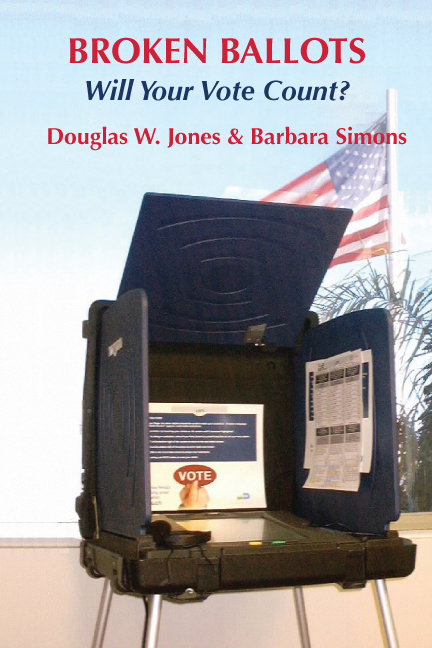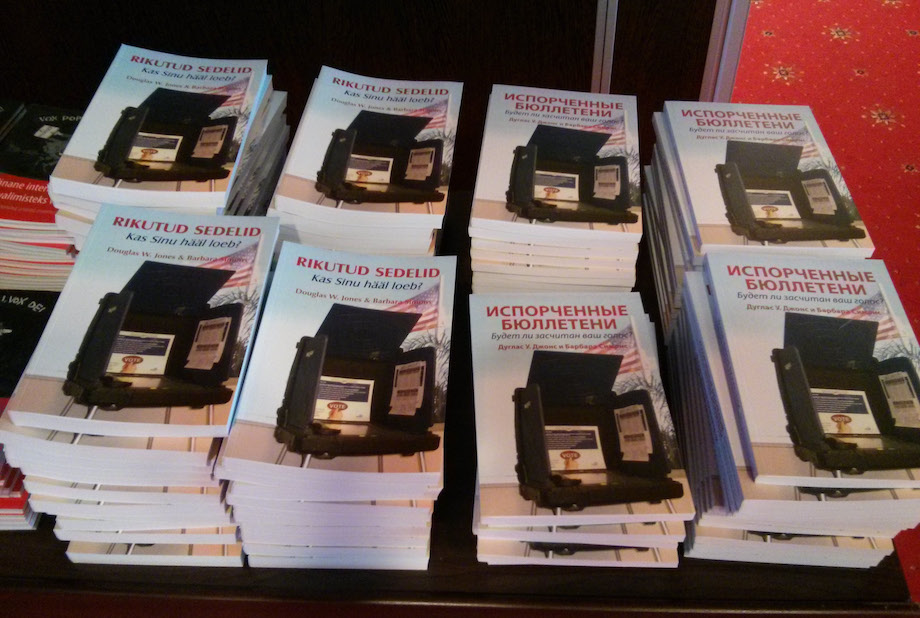
Broken Ballots
Will Your Vote Count in the Electronic Age?
Douglas W. Jones and Barbara Simons
For many of us, the presidential election of 2000 was a wake-up
call. The controversy following the vote count led to demands for
election reform. But the new voting systems that were subsequently
introduced to the market have serious security flaws, and many are
confusing and difficult to use. Moreover, legislation has not kept
up with the constantly evolving voting technology, leaving little to
no legal recourse when votes are improperly counted. How did we come
to acquire the complex technology we now depend on to count votes?
Douglas Jones and Barbara Simons probe this question, along with
public policy and regulatory issues raised by our voting
technologies. Broken Ballots is a thorough and incisive analysis of
the current voting climate that approaches American elections from
technological, legal, and historical perspectives. The authors
examine the ways in which Americans vote today, gauging how
inaccurate, unreliable, and insecure our voting systems are. An
important book for election administrators, political scientists,
and students of government and technology policy, Broken Ballots is
also a vital tool for any voting American.
April 2012 (electronic version, August 2012)
Authors' web page on the book

Now in Estonian and Russian!
Testimonials for Broken Ballots
“Broken Ballots is an extremely useful book on an extraordinarily important subject: will your vote count? As this book convincingly shows, the combination of defective technology and poor regulation have too often meant that votes are miscounted, or not counted at all. The book provides a comprehensive history of the use of voting technology in the United States, but its heart is the ‘voting technology battles’ that followed the 2000 election. That election, as the authors note, demonstrated more dramatically than any other the impact that flawed technology can have on election outcomes. Simons and Jones were not mere spectators to these battles, they have been important players. They make no apologies for their opposition to paperless computerized voting machines, or to internet voting. While not everyone will agree with their characterization of all the battles of the last decade, they provide a cogent and clear critique of current election administration and regulation, and offer several common sense solutions for increasing the accuracy and fairness of our elections. This book is a must read, not only for election officials and other policy makers, but also for public interest groups who seek to protect the vote and, indeed, for every citizen who wants his or her vote to be counted.”
Frederick A. O. Schwarz, Jr.
Chief Counsel
Brennan Center for Justice at the New York Univeristy School of Law
“Americans want to believe their votes are counted reliably, fairly, and fully, yet they have a nagging suspicion that all is not well in our country's voting systems. Broken Ballots chronicles in the greatest detail how these suspicions have been examined and how improvements have been pursued, rejected, implemented, or defeated. Jones and Simons detail the intricacies involved in maintaining the integrity of voting procedures and technologies and in protecting the outcome of elections from error or manipulation.
“Presenting evidence that ballot box access and security are under
serious threat by the push for unauditable voting machines and
untested and unsecured internet-based voting, Broken Ballots forces
us to examine closely our electoral process. As a nation, we must take
a serious look at the suggestions provided by Jones and Simons and
enact the legislation needed to make strides toward secure,
accessible, and verifiable elections. What can be more important?”
Rush Holt
Former New Jersey Congressman
CEO American Association for the Advancement of Science
April 9, 2012
“The cornerstone of our democracy is the right to vote and the right to have that vote counted as it was intended. Broken Ballots first demonstrates clearly and compellingly the extent to which that right is in jeopardy. Then it lays out a plan to preserve and protect that right. Kudos to the authors and to all those fighting to safeguard our democracy.”
Kevin Shelley
Former California Secretary of State
“Broken Ballots is the definitive source of information about voting technology, past and present. But it is not purely focused on technology issues; it also thoroughly examines the policy issues surrounding the use of various voting technology. Most importantly, it documents the history of how these issues have been dealt over the centuries.
“The authors were directly involved in making some of that history in the last decade. This recent history is a particularly fascinating case study of many aspects of the making of policy about the use of technology, including the roles of business, election officials, politicians, activist, and technologists.
“It is not possible to understand elections without understanding the technology that makes them function (or malfunction). This book is essential reading for anyone who cares about elections.”
Professor David Dill
Computer Science
Stanford University
ISBN (Paperback): 9781575866369
ISBN (Cloth): 9781575866376
ISBN (electronic): 9781575866499
|



Distributed by the
University of
Chicago Press
|



